|
| |
| |
| |
The Jesuit Connection
Relations between Flanders and China
One early player in the history of relations between China and Flanders was Willem van Rubroeck ofm, who hailed from the south-western corner of Flanders. Coming from one of the first generations of the Franciscan movement in Flanders, he is certainly among the foremost figures of the early Franciscan mission to the Far East. Although he never actually reached China, his most famous journey (1252-1255) took him to Karakorum in Mongolia, and he pointed the way for the later generations of friars who founded the Christian Church of Yuan China, leading among other things to the establishment of the dioceses of Peking (Beijing) and Fukien. After him we find no discernible traces of any relationship between Flanders and China until the sixteenth and seventeenth centuries.
The Flemish interest in China resumed within the framework of the Jesuit Mission in China, itself a spin-off of the great age of the Descobrimentos, the Portuguese discoveries in the Far East. It is significant that in a letter of 1552 the founder of the China Mission, Francis Xavier, already specifically asked for ‘Flemish and German’ fathers to be sent there. It is not entirely clear just what lay behind this preference; he may have been thinking of the physical strength of the North European fathers, necessary in the harsh conditions of that mission; maybe, also, the exemplary role of Father Gaspar Barzaeus (or Berse), a native of Goes in Zealand Flanders, inspired his choice. In any event, from the beginning Flemish fathers were part of that small pioneering band, along with representatives of other nationalities, among them the real stars of the mission, the Italian Jesuits Michele Ruggieri, Alessandro Valignano and Matteo Ricci. At this time, the presence of Portuguese groups in Bruges and Antwerp meant that these cities had long been receiving Chinese products such as Wan li porcelain and medicinal plants - including ginseng root, the description of which by Andreas Vesalius (Basel, 1546) introduced it to the rest of Europe.
In the first decade of the seventeenth century a native of Douai, Nicolas Trigault, played an important role in this mission: by his journey through Europe (1611) in search of money, books, etc, which attracted the attention of European princes, intellectuals and painters (Rubens!); by sending a series of European books on science and other subjects to Peking, which
| |
| |
formed the basis of the famous Jesuit library and the ‘scientific’ work of the Jesuits there; by his Latin translation of Matteo Ricci's account of the China Mission, which made it widely accessible and popular in Europe; by his part in developing an adequate Western transcription system for Chinese. Sadly, no detailed research on his work and reception has yet been carried out.
In the first half of the seventeenth century Flanders was represented on the Chinese scene almost exclusively by the products of its printing houses, with a splendid copy of the Biblia Polyglotta (ceremoniously received in Peking in 1604), and Hieronymus Nadal's Evangelicae Historiae Imagines (Antwerp, 1594). Both of these were produced by the famous Antwerp publishing house of Plantin, and the latter achieved widespread use in the instruction of converts. Conversely, the ‘image of China’ was received in Flanders, and disseminated inter alia in cartographic form (the China maps of Abraham Ortelius), in several (translations and) publications of Jesuit Year Letters (‘Litterae Annuae’), and in Jesuit theatre. Some collections of Chinese curiosities also came into being (for instance, the Jacob Edelheer collection in Antwerp); it is likely that they contained the same kind of items as the collections in Holland - porcelain, fans, lacquer ware, plant specimens etc. - but on a more modest scale than in the Northern Netherlands.

‘China Jesuit’, as portrayed by P.P. Rubens on the occasion of the former's stay in Antwerp in 1611. Photo courtesy Prof. dr. H. Vlieghe; cf. id, Corpus Rubenianum, Part xix Portraits, ii Antwerp Identified Sitters, no. 154c.
| |
An ‘engineer’ Jesuit
A decisive event for the Flemish presence in China was the arrival from that country of the Italian Jesuit missionary Martino Martini, who passed through Antwerp, Brussels and Leuven in the first half of 1654. His visit spurred a new generation of young Jesuits to head for China, attracted partly by Martini's stimulating personality and reports and partly by their strong desire for heroism and martyrdom. A real torrent of demands for postings to China came from the Flemish colleges, and a glance through them tells us a good deal about the applicants' motives. It was in 1655 that Albert Dorville, Philippe Couplet, Ferdinand Verbiest and Franciscus de Rougemont left Flanders, reaching China in 1659 after many vicissitudes. Together with Petrus van Hamme they became central figures of the Flemish presence in China, albeit for different reasons. Dorville's most conspicuous achievement was undoubtedly his participation, with Johann Grüber, in the first (recorded) journey by Europeans through Tibet and the Himalayas, where they were the first to describe a number of places, including the Potala in Lhasa.
Far better known, though, is Ferdinand Verbiest, who was active in Peking between 1660 and 1688 as a missionary, scientist, engineer and diplomat. His activities are relatively well documented - though not yet fully studied - thanks to a tremendously rich bibliography in (mainly) Latin, Portuguese, Chinese and Manchu. Probably his most conspicuous role was as imperial astronomer and calendar maker; the prestige that went with this position afforded him excellent opportunities to protect and promote the Christian cause. It was in this capacity that he built, between 1669 and 1674, a set of six new astronomical instruments for the Imperial Observatory in Peking, of a Tychonic type, mainly to persuade Chinese specialists of the superiority of Western astronomy. This - still extant - set combines contem- | |
| |
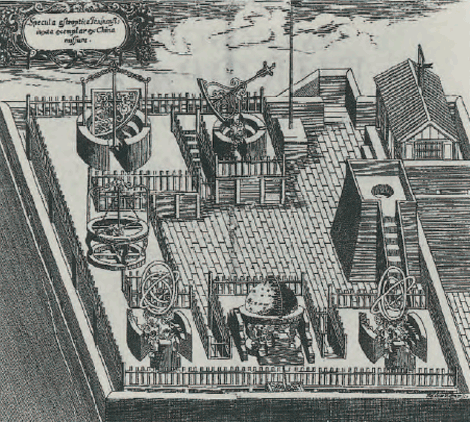
F. Verbiest's new Peking Observatory (1669-1674), etched by Melchior Haffner after his own world-famous drawing (From F. Verbiest, Astronomia Europaea, Dilingae 1687).
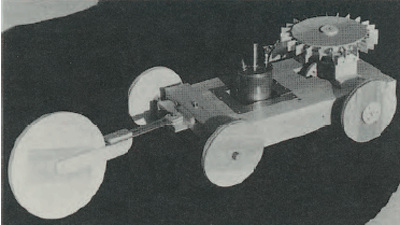
Reconstruction of F. Verbiest's automotive vehicle, built in 1984. Photo courtesy Noël Golvers.
porary European skill with Chinese artistic tradition, and is certainly a masterpiece in the history of instrument building; in addition, the ‘engineer’ explained the physical principles, the building process and the working of the instruments in both Chinese and Latin treatises, of which the former are also remarkable for the beauty of their design. They are now precious and eagerly-sought-after bibliographic rarities. One important question regarding Verbiest's instruments is just how far they were obsolete in Europe at the time they were introduced in China; however, the proven degree of ‘retardation’ can be explained as due to factors beyond their builder's control and was certainly not intentional. In any event, Verbiest also showed himself highly competent in several other mathematical disciplines, by making, adapting and even inventing machines in the fields of - among others - ballistics, canal digging, clock and dial making, by the construction of automata, etc. Probably the achievement of his which has attracted most comment was the casting of a series of some 300 military cannons, of increasing per- | |
| |
fection, and the most imaginative his development of a steam-driven automotive vehicle, later forgotten but now generally recognised as the precursor of the modern automobile! These in addition to many other more or less important achievements, for instance in the field of international diplomacy: he personally manipulated the tentative Chinese-Russian talks with a view to organising overland communications for the Jesuits between China and Europe via Siberia and Moscow. In this, too, he opened new horizons for the mission. With these manifold activities, Verbiest - whose Chinese name was ‘Nan Huai-jen’ - is still recognised in today's China as the most important figure in Sino-Flemish relations.
| |
Bringing China to Europe
Meanwhile Verbiest's colleagues from the Leuven Jesuit college, Philippe Couplet and Franciscus de Rougemont, were working in South China, in Nanking (or Chiang-nan) Province; they, far more than Ferdinand Verbiest, represent the missionary pur sang. In the case of de Rougemont, this has recently been confirmed with the (re)discovery and study of his personal account book for 1674-1676. Couplet on the other hand left China for Europe in 1681, bringing with him a 400-volume library of Chinese Christian works, as well as (mainly Latin) manuscripts by Jesuit missionaries which also covered a broad spectrum of non-Christian Chinese culture, religion, philosophy and customs. Here he developed a new side to his career. During his ten-year stay in Europe (in Flanders, Italy, France, England, Spain and Portugal) from 1684 to 1694 he was busily engaged in the publication of these manuscripts, which earned him the honorary title - a little exaggerated, but basically accurate - of ‘the man who brought China to Europe’. These works did indeed represent (following on from Matteo Ricci, Juan Gonzalez de Mendoza, Alvaro Semedo and Martino Martini) a new vein of fresh information on China, written by qualified eye-witnesses. There were, to name only a few, Ferdinand Verbiest's Astronomia Europaea (Dillingen, 1687) and his Elementa Linguae Tartaricae (Paris, 16811, 16942); the Confucius Sinarum Philosophus by Prospero Intorcetto, Philippe Couplet, Franciscus de Rougemont and Christian Herdtrich (Paris, 1687), which included a Synopsis of Chinese history, a Tabula Chronologica Monarchiae Sinicae, a Tabula Genealogica 3 Familiarum Imperialium (...) and Annales Sinici; the Nouvelle Relation de la Chine by Gabriel de Magalhaes (Paris, 1688); the
revision of a basic Chinese grammar; and many others. During his stay in Europe, moreover, Couplet was in contact, directly and / or through correspondence, with several scholars who were trying to acquire a knowledge of the Chinese language: Christian Menzel in Berlin, Thomas Hyde in Oxford, Melchisedech Thévenot and Louis Picques in Paris, who represent the first generation of European sinologists. In fact Couplet's prime objective was always to promote and defend the interests of the Chinese Mission in Rome and in Europe; but his intellectual contribution is none the less important for that.
Couplet's death on his return to China in 1694 meant the end of a period (1654-1694) which had started with Martini's arrival in Antwerp. The presence of Flemish Jesuits in China and the apparently uninterrupted (though
| |
| |
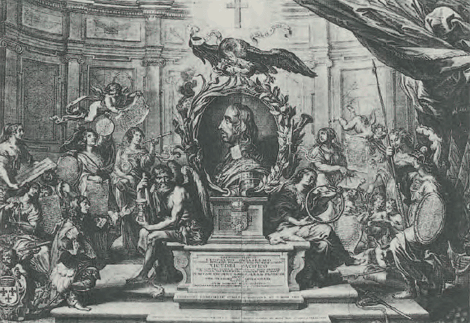
Flemish engraving (Antwerp), accompanying the dissertation of Th. d'Immerselle at the Jesuits' mathematical school in Leuven in 1652. Imitated afterwards in China. (Noël Golvers, T'oung Pao, lxxxi, 1995, 303-314).
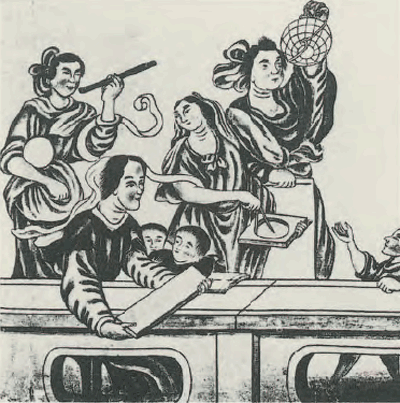
Allegory of the Muses of European Science, a Chinese imitation of the engraving in d'Immerselle's dissertation (From B. Laufer, 1911).
indirect) contacts, centring especially around Balthasar ii and Balthasar iii Moretus and the Antwerp Jesuit house, had given Flanders a great opportunity to play an important role in the ‘intellectual’ approach of Europe to China. But nothing came of it, because of a lack of interest. Even the China-topic in Flemish Jesuit theatre was restricted to stereotypes. In Antwerp, the Bollandist Father Daniel Papebrochius was an active supporter of the China mission; but we find no sign of any broader interest. Apart from Martini's De Bello Tartarico (Antwerp, 1654) no major books on China appeared in the Southern Netherlands, and even such an epoch-making work as the Novus Atlas Sinensis (Amsterdam, 1654) - originally offered for publication to the Antwerp printers - was rejected by the local printers. A lack of linguistic interest - compared to neighbouring countries - also indicates a very limited interest in this part of the expanding world. Meanwhile, ‘Flemish’
| |
| |
books and prints (engravings, emblems) did occasionally get as far as China, and Couplet and de Rougemont played a substantial part in the production of the first Latin translation of (three of) the four Chinese Classics, published in Paris in 1687 as Confucius Sinarum Philosophus.
The situation did not change with the arrival in China in 1689 of Petrus van Hamme. Much of his correspondence has been preserved, but still awaits proper collection and study. In this eighteenth-century phase, one new element is certainly an increased interest in commercial relations with China (most notably the tea trade), culminating in the rise and eventual suppression of the Ostend Company (1722-1774). This organisation, together with other enterprises in decades that followed, brought a vast array of Chinese objets d'art to the Southern Netherlands and also contributed to the assimilation of ‘Chinese’ customs such as tea drinking and other chinoiseries in urban centres there.
| |
The Scheut mission
The last phase of Flemish-Chinese relations begins in the nineteenth century, when the creation of the Belgian Kingdom gave a new context - and to some extent a new élan - to Flemish interest in China. Apart from the contributions of individuals such as Paul Splingaerd, in the fields of diplomatic and economic relations among others, it is again the missionary enterprise, and some of its spin-offs, which is most conspicuous. Here we think in the first place of the contribution of the missionary congregation of Scheut
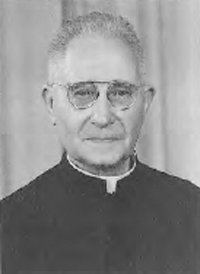
Father Antoon Mostaert cicm (1881-1971), one of the world's foremost Mongolists. Photo courtesy F. Verbiest Foundation.
( cicm) in China and Inner Mongolia, memorable both for the heroism of the venture and for its participation in the scientific exploration of those areas. Especially deserving of mention here are Antoon Mostaert cicm and Jos Mullie cicm. The former still ranks among the foremost mongolists, and his works, including Dictionnaire Ordos (Vol. i, 1941; ii, 1942; iii, 1944), Le dialecte Monguor (Vol. i, 1931; ii, 1945) and Le dialecte des Mongols Urdus (1926-1930) remain landmarks in the field. Jos Mullie is mainly known for his studies on Chinese; his Chinese Idiom (Het Chineese taaleigen, 1930-1931) and Principles of Chinese Literary Language (De grondbeginselen van de Chinese letterkundige taal), among others, are still important works. He and his fellow fathers also considerably advanced the study of archeology, folklore and even paleontology, individually or in collaboration with leading specialists such as Teilhard de Chardin sj. The cicm enterprise had to abandon its activities in the field in 1949; but its work in the domain of humanitarian aid projects and historical research continues in the Ferdinand Verbiest Foundation (Catholic University of Leuven).
In recent decades, too, economic collaboration (such as joint-ventures) opened up new horizons. This brief survey shows how for more than 700 years Flemish people, most of them missionaries, have contributed within the context of their own ‘mission’ to a better understanding of Chinese people, and how substantial their contribution often was.
noël golvers
|
|